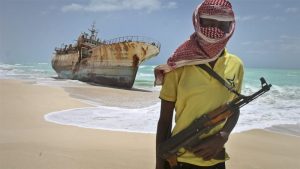What do do about pirates
Cerulli Global Edge: The next wave of sovereign wealth funds
1 March, 2011Chinese telecoms embrace 3G
1 March, 2011Emphasis Media, March 2011
There’s an odd contradiction in the way we see piracy today.
On one hand we have Johnny Depp, with bandana and beaded beard, ready to unleash a fourth installment of the Pirates of the Caribbean movie franchise. His Jack Sparrow, all Keith Richard swagger and reprobate swigger of rum, has become one of the most iconic characters Hollywood has produced in the last 10 years. Our attachment to the romantic Long John Silver type, of eyepatches and parrots, wooden legs and a hearty “Arrrr!”, still clearly holds fast. Pirates of this salty sea-dog style even hold a popular place in children’s culture; one of the most popular characters among the Australian preschool megastars The Wiggles is the cheerfully inept Captain Feathersword.
And yet on the other hand, maritime piracy has never in living memory been a bigger problem than it is today. It is, in every possible respect, getting worse: more attacks, on bigger vessels, with more brutality, more sophisticated weapons and over an ever-bigger area. And in Somalia, the root of the modern problem, there is just no obvious way to fix it.
It has been said that piracy is as old as ocean commerce itself. It’s certainly been a fixture in the Mediterranean for at least 3,000 years, and turns up prolifically in Greek and Roman history: Julius Caesar, in one of the less celebrated moments of his career, was captured by pirates for ransom (and, when the ransom was paid, immediately sent a fleet to kill the pirates and get it back again). Since then, wherever there has been naval activity, and wherever trade has taken place on the seas, there have been pirates too.
Regardless of where they appear in geography or history, pirates have rarely been pleasant to deal with, which makes it puzzling that the swashbuckling image has risen to such popularity in modern culture. It probably dates from the Buccaneering age, from about 1650 onwards, when a growth in seaborne trade was reflected in a blossoming of equally active piracy to steal from it. This is the era of Blackbeard and Calico Jack, rock stars of their time, and over the following centuries these caricatures found their way into literature for authors such as Robert Louis Stevenson (whose Treasure Island introduced the world to Long John Silver) and JM Barrie (whose Peter Pan featured Captain Hook).
Today, there is not a shred of romance attached to piracy. It is a brutal, mushrooming menace. There were 239 attacks worldwide in 2006; in 2010, 445. In 2006, 53 attacks involved guns; in 2010, 243. Seven ships were fired upon in 2006; 107 were in 2010 – and these days the attackers are likely to be armed with rocket-propelled grenade launchers. And while 188 unlucky people were held hostage in 2006, by 2010 the figure had risen to 1,181.
All these figures come from the ICC International Maritime Bureau’s Piracy Reporting Centre, and its head, Captain Pottengal Mukundan, pins the blame chiefly on one state: Somalia, which accounted for 139 of the 2010 attacks and was the source for a further 80 from the Red Sea and Gulf of Aden to deep in the Indian Ocean. “The most important fact is that Somalia is a failed state and there are no law enforcement agencies, or anyone else, to deal with this,” he says. “And there isn’t really any strong deterrent against these criminals.” Ransoms are readily paid and so more is asked for each time. On top of that, a new technique of hijacking an ocean-going vessel – sometimes as big as a tanker – and then using that as a mother ship from which to launch other attacks gives the pirates an almost limitless range of operations.
The world has plenty of examples of piracy being effectively dealt with. Southeast Asia, and in particular the Malacca Straits, used to be a hotbed of piracy, but attacks there peaked in 2004; Indonesia, Malaysia and Singapore took action and have largely solved the problem. There was a period when the South China Sea, and in particular the Gulf of Tonkin, were a problem; China took action, executed pirates and that problem stopped too. But there’s no way to bring such measures in Somalia because there’s nobody there in a position to do it. “We have not in the recent past had the scenario we have here: a failed state with a very large coastline,” says Mukundan. The long term solution is to fix the country itself, to build infrastructure, encourage foreign investment and provide a functioning economy. But that, he says, is “a very long term project.”
In the meantime, the responses of attacked ships and their flag states has started to become considerably more animated. When a South Korean tanker, the Samho Jewelry, was hijacked in January, the country’s navy went in, stormed it, killed eight pirates and captured the rest. Malaysia’s navy has taken a similar approach. Elsewhere, there are agreed standards for ships and their masters going around the Horn of Africa, setting a policy for reporting suspected attacks, sharing information and working together. Oddly, it has brought together navies of countries that have never been allies – sometimes quite the reverse – to try to deal with an increasingly global problem. So with more firepower and aggression on both sides, what comes next? The battle lines have been drawn.
